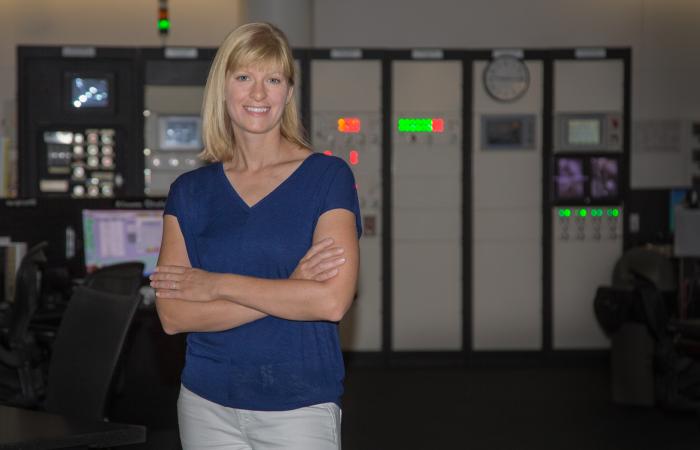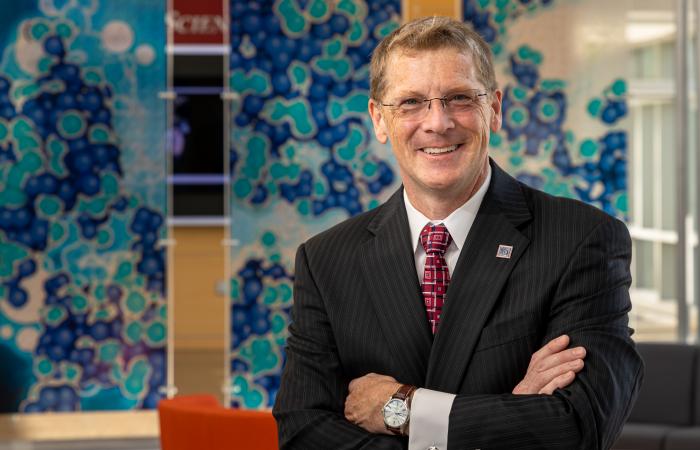Two scientists with the Department of Energy’s Oak Ridge National Laboratory have been elected fellows of the American Physical Society.
Sarah Cousineau, a section head in the Research Accelerator Division at the Spallation Neutron Source, is recognized for her “high-impact contributions to high-power proton accelerator research, inspiring workforce education and effective leadership in the physics of beams.” Sean Hearne, director of the Materials Science and Technology Division, was named in recognition of his “outstanding contributions to the science and technology of thin-film materials, and for visionary leadership of research institutions and professional societies.”
Sarah Cousineau previously served as the group leader for Beam Science and Technology and was named head of the new Accelerator Science and Technology section in 2020.
“I am honored to be elected as a fellow of the APS,” she said. “I am thankful for the SNS team who enabled this honor. All of my career accomplishments have been born from working with this remarkably talented and creative group of people.”
After earning a doctorate in accelerator physics from Indiana University in 2003, she joined ORNL as a postdoctoral scientist. Now as a section head, she leads three groups of scientists, engineers and technicians dedicated to advancing accelerator physics, engineering research and development, and beam instrumentation at the SNS, a DOE Office of Science user facility.
Cousineau has received numerous honors for mentoring, including the Mentor Excellence Award from the DOE Office of Science in 2003 and 2008. In 2015, she received the ORNL Mentor of Undergraduate Student Researchers award. In 2017, she received an ORNL Significant Event Award for “Demonstration of Microsecond H- Laser Assisted Stripping.” She is the current chair-elect for the APS Division of Physics of Beams and chairs the curriculum committee for the U.S. Particle Accelerator School, a semi-annual program that provides training in the science and technology of particle accelerators.
Her current engagement with APS is her second stint in serving in the society’s governance. During her postdoc years, Cousineau served as a member at large and recalls feeling uncertain of what she should do in the role.
“I was young and wasn’t sure what I was supposed to be doing — I felt very out of place,” she said. “So, in this second pass, I’ve made it a mission to add more structure and programs for junior scientists, such as students and postdocs. They appreciate opportunities to be engaged and contribute.”
She spearheaded new scholarship opportunities for student travel to the U.S. Particle Accelerator School and the APS meetings, and this year, the APS Division of Physics of Beams is introducing an outstanding paper award through its journal. Her work with the particle accelerator school curriculum committee is inspired by the positive experience she had with the school as a graduate student.
“This two-week training program actively serves the needs of the field. As DOE is building new projects, we can train people for the expertise needed,” she said. “It’s very intense, but everyone in the field loves particle accelerator school. It allows attendees, including many graduate students and postdocs, to both learn new science and make critical professional connections.”
Cousineau’s appreciation for what particle accelerators have contributed to science underpins her drive to support and mentor new scientists in the field.
“Ever since their advent in the 1940s, accelerators have directly influenced a Nobel Prize in physics on average every three years — you can connect the breakthrough to work done on an accelerator,” she said. “Accelerators have filtered into technology in many aspects of our lives: isotope production for medical treatments, machines used in cancer therapies, food inspection technology, and security and defense applications. There is an exponential curve to what accelerators contribute to science and society.
“Accelerator science enables the advancement of many other fields. Each generation of accelerator has a deeper understanding of the physics of the particle beam and spins off new applications that enter industry and our normal lives.”
Sean Hearne, a lifetime member of APS, said, “It is quite an honor to be recognized by APS.”
“I've spent my career working in material science, but my roots are in physics,” he said. “Being able to apply the techniques and foundations that I learned from the physics community in the materials space has brought me great pleasure.”
After earning a doctorate in solid state physics from Arizona State University, Hearne’s early career focused on research to advance materials science, nanofabrication and energy storage at Intel Corporation and Sandia National Laboratories. In 2001, he joined Sandia National Laboratories to be one of the founding scientists at the Center for Integrated Nanotechnologies, or CINT, which is jointly operated by Sandia and Los Alamos National Laboratory. At Sandia, his career progressed, and he was named senior manager of Sandia’s Ion Beam Laboratory and the co-director of CINT. He joined ORNL in 2019 as director of the Center for Nanophase Materials Sciences.
Hearne holds multiple patents in micro- and nanofabrication techniques and systems. He was the 2018 president of the Materials Research Society, an invited energy review editor of the Journal of Materials Science, a Springer-Nature publication and currently holds a joint facility position at the University of Tennessee, Knoxville, Bredesen Center for Interdisciplinary Research and Graduate Education.
Hearne currently leads a division that conducts fundamental and applied materials research for basic energy sciences programs and a variety of energy technologies, including energy efficiency, renewable energy, transportation, conservation, fossil energy, fusion energy, nuclear power, and space exploration.
“ORNL is dedicated to solving the most challenging materials problems facing our nation,” he said. “Quantum materials, energy storage, and new advanced manufacturing materials and techniques for addressing the nation’s transportation, power and defense needs — all these things have their roots in understanding and controlling properties of materials. It’s an exciting space to be working in.”
Hearne learned how valuable and supportive professional societies could be when he became active in the Society for Physics Students during his early years at Arizona State University in Tempe, Arizona.
“Struggling through electricity and magnetism and quantum together as physics students built a very close group that I’m still in contact with 30 years later,” he said.
He sees the benefits of society involvement in his management career as well.
“Close ties with professional societies such as APS help to bring new talent into the laboratory,” Hearne said. “We’re always striving to improve the diversity within the National Laboratory system and that starts with building relationships with students and professional societies.”
UT-Battelle manages ORNL for the DOE Office of Science. The single largest supporter of basic research in the physical sciences in the United States, the Office of Science is working to address some of the most pressing challenges of our time. For more information, please visit energy.gov/science/.



